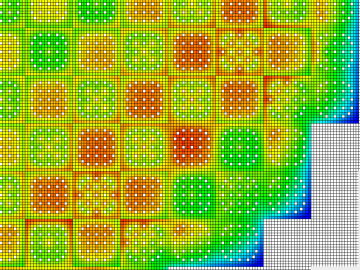
Filter News
Area of Research
- (-) Nuclear Science and Technology (19)
- (-) Supercomputing (61)
- Advanced Manufacturing (22)
- Biological Systems (2)
- Biology and Environment (126)
- Biology and Soft Matter (1)
- Building Technologies (1)
- Computational Engineering (1)
- Computer Science (1)
- Electricity and Smart Grid (1)
- Energy Science (154)
- Functional Materials for Energy (1)
- Fusion and Fission (11)
- Fusion Energy (8)
- Isotopes (25)
- Materials (59)
- Materials for Computing (6)
- Mathematics (1)
- National Security (11)
- Neutron Science (18)
- Nuclear Systems Modeling, Simulation and Validation (1)
- Quantum information Science (1)
News Topics
- (-) 3-D Printing/Advanced Manufacturing (8)
- (-) Advanced Reactors (12)
- (-) Bioenergy (9)
- (-) Environment (23)
- (-) Frontier (32)
- (-) Isotopes (7)
- Artificial Intelligence (37)
- Big Data (22)
- Biology (11)
- Biomedical (19)
- Biotechnology (2)
- Buildings (4)
- Chemical Sciences (5)
- Computer Science (97)
- Coronavirus (14)
- Critical Materials (3)
- Cybersecurity (9)
- Energy Storage (8)
- Exascale Computing (26)
- Fusion (9)
- Grid (5)
- High-Performance Computing (43)
- Machine Learning (15)
- Materials (15)
- Materials Science (19)
- Mathematics (2)
- Microscopy (7)
- Molten Salt (5)
- Nanotechnology (11)
- National Security (8)
- Neutron Science (17)
- Nuclear Energy (39)
- Partnerships (1)
- Physics (10)
- Polymers (2)
- Quantum Computing (20)
- Quantum Science (25)
- Security (6)
- Simulation (16)
- Software (1)
- Space Exploration (8)
- Summit (43)
- Transportation (6)
Media Contacts

The U.S. Air Force and Oak Ridge National Laboratory launched a new high-performance weather forecasting computer system that will provide a platform for some of the most advanced weather modeling in the world.

A new tool from Oak Ridge National Laboratory can help planners, emergency responders and scientists visualize how flood waters will spread for any scenario and terrain.

Six scientists at the Department of Energy’s Oak Ridge National Laboratory were named Battelle Distinguished Inventors, in recognition of obtaining 14 or more patents during their careers at the lab.

The annual Director's Awards recognized four individuals and teams including awards for leadership in quantum simulation development and application on high-performance computing platforms, and revolutionary advancements in the area of microbial

The combination of bioenergy with carbon capture and storage could cost-effectively sequester hundreds of millions of metric tons per year of carbon dioxide in the United States, making it a competitive solution for carbon management, according to a new analysis by ORNL scientists.

Radioactive isotopes power some of NASA’s best-known spacecraft. But predicting how radiation emitted from these isotopes might affect nearby materials is tricky

A developing method to gauge the occurrence of a nuclear reactor anomaly has the potential to save millions of dollars.

It’s a new type of nuclear reactor core. And the materials that will make it up are novel — products of Oak Ridge National Laboratory’s advanced materials and manufacturing technologies.

As CASL ends and transitions to VERA Users Group, ORNL looks at the history of the program and its impact on the nuclear industry.

After its long journey to Mars beginning this summer, NASA’s Perseverance rover will be powered across the planet’s surface in part by plutonium produced at the Department of Energy’s Oak Ridge National Laboratory.


